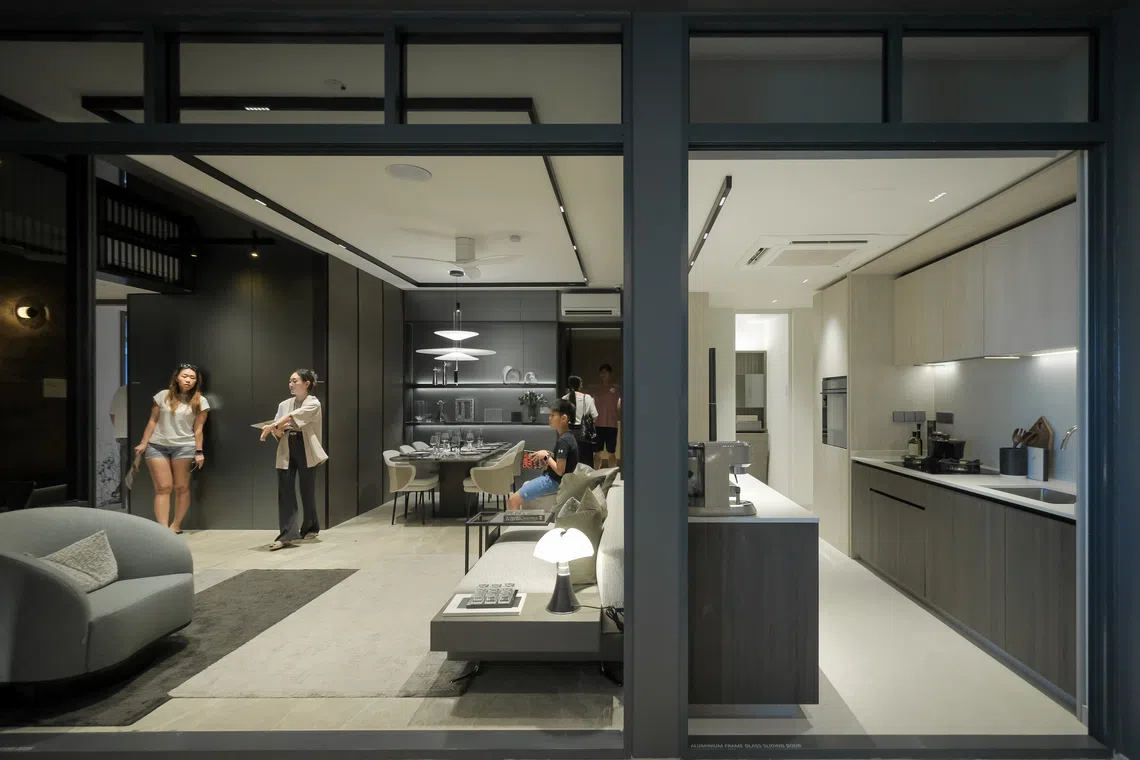Regulatory changes in Singapore to simplify show-flat site sourcing for developers
Sign up now: Get ST's newsletters delivered to your inbox

The Urban Redevelopment Authority and Singapore Land Authority have pre-identified a list of vacant state land sites for show-flat use.
PHOTO: ST FILE
Follow topic:
- Agencies pre-identify vacant state land for showflats, listed on SLA's portal, saving developers six weeks in approval time.
- Central Area showflat TOLs (Temporary Occupation Licences) can now be approved upfront for three years, addressing industry feedback.
- Conquas refocuses on functionality, removing 30% of defect categories, giving time savings to firms with good bandings.
AI generated
SINGAPORE – Making it easier for developers to source private residential show-flat sites was among several changes announced on Nov 13 to reduce costs and create a more business-friendly environment for the real estate sector.
“We have heard your feedback that sourcing show-flat sites can be challenging and time-consuming,” National Development Minister Chee Hong Tat said at the 66th anniversary dinner of the Real Estate Developers’ Association of Singapore (Redas) held at Shangri-La hotel.
To simplify the process, the Urban Redevelopment Authority (URA) and Singapore Land Authority (SLA) have pre-identified a list of vacant state land sites for show-flat use. Starting on Nov 14, this list of sites will be available on SLA’s portal for temporary occupation licences (TOLs).
Developers applying for TOLs for the pre-identified sites must submit their show-flat layout plans to the relevant agencies for approval. This is to ensure compliance with the specific conditions of the site.
“This will enable developers to enjoy significant time savings of about six weeks and halve the time it currently takes to obtain agencies’ approvals,” Mr Chee said.
Those who find the pre-identified sites unsuitable for their use may identify other sites and submit their applications to SLA under the usual process.
For projects within the Central area, developers may now obtain upfront approval for a three-year TOL for show-flats located in this area. Previously, shorter durations of up to two years were granted.
This enhancement is to address industry feedback about insufficient time for marketing activities, URA and SLA said in a Nov 13 circular to the industry.
The circular, which takes immediate effect, is valid for three years. Renewals beyond the three-year period may be considered when nearing expiry, subject to approvals and any new site conditions. The TOL renewal duration will also be assessed as part of the process, they added.
In the past, it was common to have the show-flat gallery on the site where the condo is to be built, but that can interfere with construction, particularly for smaller sites.
Developers also say that securing suitable land is not easy, especially if there are many new launches.
If sales are slow, some developers may extend existing show-flat leases, making available gallery sites even harder to obtain for others.
A spokesperson for Redas said the pre-identified sites for show-flat use will help shorten preparation timelines and give developers greater certainty in their planning.
Mr Chee noted that the changes are part of a government-wide initiative with industry partners including Redas to review policies, rules and processes to cut red tape, and help businesses reduce costs and save time.
“At the same time, we hope that developers will also continue to adopt innovative and land-efficient approaches, such as virtual show-flats, given our limited supply of land,” he added.
Enhancements will also be made to the Construction Quality Assessment System (Conquas) framework for private residential projects to keep pace with new developments, Mr Chee said.
Conquas is Singapore’s national standard for assessing workmanship quality in government projects and bigger developments when they are completed. It is usually applied to larger-scale projects, such as private condominiums and public housing developments with a contract value of $5 million and above.
“We are refocusing our assessment priorities on functionality and liveability defects that matter most to home owners, such as water seepage and ponding,” he said.
“Checks on minor finishing issues like stains and tonality will be streamlined. We will remove about 30 per cent of the defects categories that do not impact liveability significantly.”
These enhancements ensure construction standards evolve to meet residents’ needs, while supporting industry productivity and growth, Mr Chee said.
Home owners can look forward to better-quality homes with fewer defects, while developers can benefit from time savings through more efficient assessments, he added.
“Firms with consistently good Conquas bandings can enjoy 20 per cent time savings from their assessment durations,” he said.


